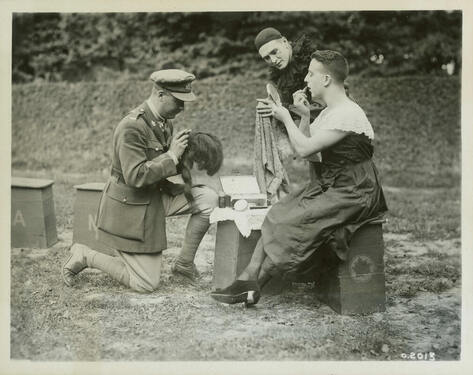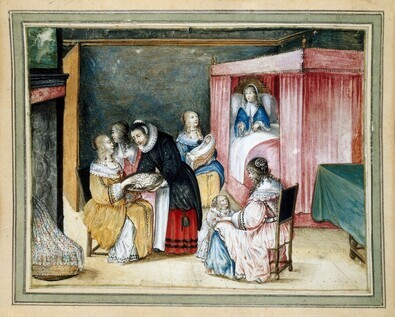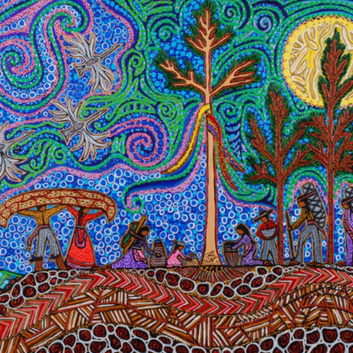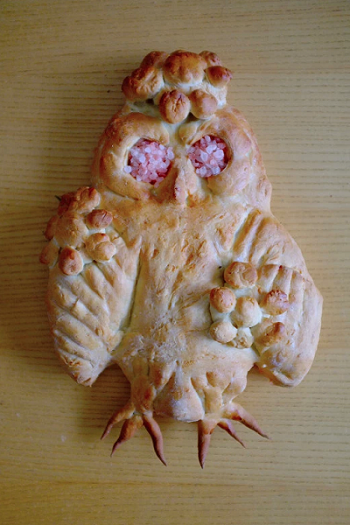David Tickner's Blog, page 11
September 15, 2023
Weird
 Have you seen the TV commercial in which someone is eating a snack made with eggs?
Have you seen the TV commercial in which someone is eating a snack made with eggs?“That’s weird,” says a person watching the other eat.
“What’s weird?” asks the person eating.
“Eating eggs for a snack…”
“That’s not weird. You’re weird for thinking it’s weird.”
Do you ever encounter something that seems strange, eerie, creepy, mysterious, unnatural, peculiar, uncanny—you know, something that seems weird? Have you ever called someone a weirdo? Have you ever felt that you were being ‘weirded out’ by something?
Weird comes from the Proto-Indo-European (PIE) root wer-(2) (to turn, to bend). So, what’s weird about that? We hear phrases such as ‘it’s your turn’, ‘as the world turns’, and ‘do someone a good turn’. Again, what’s weird about that?
We say, “Let’s wait and see how things turn out.” And later, perhaps, we say, “Was that ever weird how things turned out…”
Weird is about how things in life turn out. The word weird (having the power to control fate) came to English around 1400 from Old English wyrd (fate, chance, fortune; destiny; that which happens). The word weird has its origins in PIE wer-(2) and in the related Germanic and Norse words meaning fate, chance, and destiny, all referring to the sense that ancient gods and goddesses controlled the directions of human life.
In Germanic and Norse mythology, the Norns were the three goddesses of fate who represented the past, present, and future. The Norns were called the ‘weird sisters’ or the ‘sisters of fate’.
Even now we still carry a mysterious sense of things being predestined or ‘written in the stars’ or ‘meant to be’. Have you read a horoscope lately?!
Given that a person’s fate will include both positive and negative aspects, how did the word weird get to have such a dark side? This appears to have happened relatively recently. For example, in some popular 19th century productions of Macbeth the three sisters were portrayed as malevolent and frightening witches.
Now when we say we have a weird feeling about something, we have an ominous sense of foreboding. Somehow the three sisters have got something in for us. Watch out.
Anyway, seems like I’m fated to go and have another egg snack.
Image: https://skjalden.com/norns/
Reference: Online Etymological Dictionary, https://www.etymonline.com/
Published on September 15, 2023 08:15
September 11, 2023
Drag
 The word drag comes to English almost unchanged from its Proto-Indo-European (PIE) origins in dhregh (to draw, to drag on the ground). Over the centuries the word drag has been used in many ways.
The word drag comes to English almost unchanged from its Proto-Indo-European (PIE) origins in dhregh (to draw, to drag on the ground). Over the centuries the word drag has been used in many ways.The use of drag in the sense of women’s clothing worn by a man is from British theatre slang of the 19th century; i.e., from long skirts trailing or dragging on the floor. One suggested source of this meaning of the word drag is from German tragen (to wear).
During both World Wars One and Two, male soldiers routinely dressed as women in theatrical and musical programs designed for the entertainment of the all-male military camps (even for morale-boosting shows staged in prisoner-of-war camps). The term ‘drag queen’ is from 1941.
For example, beginning in 1916, World War One military authorities were encouraging and organizing concert parties for the soldiers during their periods of rest. By war’s end, almost every division had its own entertainment troupe, as well as performers in many of the units and formations. Soldiers were entertained by songs, skits, and cross-dressing vaudeville acts. One of the most well-known groups was the Dumbells, a troupe of Canadian soldier entertainers which continued to perform in various manifestations until 1955.
In the early 1960s, my parents went to a Hallowe’en party organized by their square dance club. My mom dressed as a man and my dad dressed as a woman. No one recognized them at the party. They won First Prize for best costumes!
In brief, “Drag performers are artists and entertainers, so being in drag is not an integral part of their identity in the same way that gender is. On the other hand, when a transgender person comes out and asks people to use a different name and different gender pronouns to refer to them, it is not part of a performance” (National Center for Transgender Equality, 2017).
Other uses of the word drag include:To draw (or walk) along slowly, 1580s.To move heavily or slowly, to hang with its weight while being moved, 1660s.Anything attached to a moving body that retards its progress, 1708.A device to stop the rotation of wheels, 1795.An annoying or boring person or thing, “What a drag!”, 1813.The ‘main drag’; i.e., the main street, 1851.A drag-out or drag-down violent fight, 1859.To take a puff on a cigarette, 1914.Thieves’ slang for an automobile, from the sense of dragging a wagon or buggy, 1935; hence, drag racing, 1947.To drag one’s feet, to delay deliberately, 1946.
Image: Members of the World War One Dumbells troupe preparing for a show
Reference: Online Etymological Dictionary, https://www.etymonline.com/
https://transequality.org/issues/resources/understanding-drag
https://www.warmuseum.ca/firstworldwar/history/life-at-the-front/trench-culture/concerts-and-theatre/
https://transequality.org/issues/resources/understanding-drag
Published on September 11, 2023 07:54
September 8, 2023
Artificial Intelligence
 Artificial
ArtificialThe word artificial has its origins in Latin artifex (craftsperson, artist, master of an art; e.g., music, acting, sculpting, painting, etc): from Latin ars (art) + fex (maker), from facere (to make); literally, to make art.
Related words include Latin artificialis (of or belonging to art) and artificium (a work of art; skill; theory, system).
By the late 14th century, the English word artificial meant something not natural, not spontaneous, and, by the early 15th century, something contrived by human skill and labor. By the 16th century artificial meant anything made in imitation of, or as a substitute for, what is natural.
In the 1590s, artificial also meant full of affectation, insincere. In the 1640s, artificial also meant fictitious, assumed, not genuine, or of suspicious origins.
Intelligence
The words intelligence and intelligent have their origins in the Proto-Indo-European (PIE) root leg-(1) (to collect, gather, to speak, to pick out words) and Latin intelligere (to understand, to comprehend, to come to know) from Latin inter (between) + legere (to choose, pick out, read).
Related words include Latin intelligentem (discerning, appreciative) and intelligentia (understanding, knowledge, power of discerning; art, skill, taste).
The word intelligence came to English in the late 14th century meaning the highest faculty of the mind, the capacity for comprehending and understanding general truths.
The notion of multiple intelligences is from Howard Gardner (1983); i.e., there is more than one way to be intelligent.
In brief
The term artificial intelligence (the science and engineering of making intelligent machines) was coined in 1956. The abbreviation AI is from 1971—not to be confused with AI meaning artificial insemination, a term from 1894!
Artificial intelligence (AI) may not be ‘natural’ but it is ‘real’, like using a car rather than a horse to get from one place to another. You still get to the destination regardless of how you get there.
AI, like a car or a horse, is a way to get something done. AI is a tool to do a job. What are the jobs to be done? What do we need from AI? What do we do with what we receive from AI?
In a current magazine article, Sam Altman, CEO of OpenAI, the home of ChatGPT, was asked what future jobs might look like in the context of increasing AI applications. He replied, “he suspects that there will be a wide range of jobs for which people will always prefer a human… [Altman’s] chosen example was teachers. [In addition] he also said that we would always need people to figure out the best way to channel AI’s awesome powers. ‘That is going to be a super valuable skill,’ he said. ‘You have a computer that can do anything; what should it go and do?’” (Andersen, 2023, 63).
How do we bring our ‘intelligence’ to artificial intelligence?
Image: AI / Humans, Andrew Curry
Reference: Online Etymological Dictionary, https://www.etymonline.com/
Andersen, R. (2023, September). Inside the revolution at OpenAI. The Atlantic, 332(2), 52 – 67.
Published on September 08, 2023 15:59
August 31, 2023
Cider
 The word cider has its origins in Hebrew shekhar, a word generally translated as any strong drink or intoxicating beverage that is distilled rather than fermented. Shekhar is related to Greek sikera, Latin sicera, and Arabic sakar, words also meaning any strong drink.
The word cider has its origins in Hebrew shekhar, a word generally translated as any strong drink or intoxicating beverage that is distilled rather than fermented. Shekhar is related to Greek sikera, Latin sicera, and Arabic sakar, words also meaning any strong drink.The English word cider (strong liquor, strong drink) appears in the 13th century from Old French cidre and Latin sicera.
During the English medieval period, the word cider was a generic term referring to any liquor or strong drink made from the juice of fruits. Similarly, during this period the word, the word apple was also a generic term referring to any type of fruit. In brief, during this period, the term ‘apple cider’ would have meant any fruit-based strong drink.
Only after the 17th century did the word apple begin to mean the specific fruit now known as an apple. And, not until the 19th century did the word cider refer specifically to a fermented fruit drink made from the fruits now called apples.
What is the difference between hard cider and sweet cider? Hard cider is fermented and alcoholic. Sweet cider is simply the juice of apples.
What is the difference between apple cider and apple juice? Apple cider is fresh, unfiltered, and often unpasteurized. Apple juice is filtered and pasteurized.
Cheers!
Reference: Online Etymological Dictionary, https://www.etymonline.com/
Published on August 31, 2023 20:10
August 25, 2023
Gossip
 In its origins, the word gossip embraced care and compassion. Today, not so much so.
In its origins, the word gossip embraced care and compassion. Today, not so much so.The word gossip comes from Old English godsibb (godparent), from god + sibb (kinship, relationship; love, friendship, peace, happiness). In 13th and 14th century English, a godsibb was a friend or neighbour, one of a group of women friends invited to attend a birth.
By the 1560s, gossip was the engagement in casual conversation and in familiar or idle talk.
However, from the 1620s, the verb ‘to gossip’ meant simply to talk idly about the affairs of others. In the early 19th century, this meaning was extended to include trifling talk or groundless rumor about others.
The word sibling, from 1903, now meaning a brother or sister, is a revival of Old English sibb and sibling which meant a relative or family member.
Reference: Online Etymological Dictionary, https://www.etymonline.com/
Published on August 25, 2023 10:32
August 21, 2023
Bandanna
 The word bandanna or bandana came to English in 1752 from Hindi bandhnu, a method of dyeing cloth, from Sanskrit badhnati (binds) and the Proto-Indo-European (PIE) root bhendh (to bind). The bandhnu dyeing technique involves tying or binding the cloth in different places in ways similar to modern tie-dyeing. The unique pattern which is created is what makes the cloth a bandanna.
The word bandanna or bandana came to English in 1752 from Hindi bandhnu, a method of dyeing cloth, from Sanskrit badhnati (binds) and the Proto-Indo-European (PIE) root bhendh (to bind). The bandhnu dyeing technique involves tying or binding the cloth in different places in ways similar to modern tie-dyeing. The unique pattern which is created is what makes the cloth a bandanna.PIE bhendh is also the source of words such as Middle Irish bainna (bracelet), Old English bendan (to bend a bow), and Old English bindan (to bind). In addition, PIE bhendh is the source of bond, bundle, cummerbund, ribbon, and others.
Reference: Online Etymological Dictionary, https://www.etymonline.com/
Published on August 21, 2023 19:52
August 16, 2023
Acknowledgement
 Artist: Leah Dorion
Artist: Leah Dorionhttps://newjourneys.ca/en/articles/celebrating-a-deep-cultural-connection-to-the-land
What is an acknowledgement?
The verb ‘to acknowledge’, meaning to admit or to show one’s knowledge, appears in English in the late 1400s. At that time, acknowledge was a blend of two Middle English words—aknow (to admit, to show one’s knowledge) and cnawan (to recognize).
The word acknowledge is from Old English oncnawan (to understand, to come to recognize), from Proto-Germanic knew, and from the Proto-Indo-European (PIE) root gno (to know).
The noun acknowledgement, meaning the act of acknowledging, appears in English in the 1590s. By the 1610s, an acknowledgement was a “token of due recognition” (Online Etymological Dictionary).
In the Acknowledgements section of a book, the author recognizes the support and contributions made by certain individuals and groups to the work.
Since the late 1990s, the term ‘ACK’ (an abbreviation of acknowledgement) appears in digital communication protocols. ACK is a signal sent by a device to indicate that data has been successfully received.
What are Indigenous land or territorial acknowledgements? “Land acknowledgements, also known as territorial acknowledgements, are short statements that recognize both the land and the Indigenous people who lived — and in many situations continue to live — on the land prior to Canada’s colonial history” (The Canadian Encyclopedia). In Canada, such acknowledgements became common following the publication of the 2015 Truth and Reconciliation Report.
A land or territorial acknowledgement at the beginning of a public gathering is a statement or admission of ‘what is’. Such an acknowledgement is a token of due recognition or recognition which is due (or perhaps overdue).1 The unsaid response to a land acknowledgement is “Yes, I got the message” or simply “Message received”.
And, of course, a land or territorial acknowledgement is but one of many actions that follow from the Truth and Reconciliation Report.
1 Land acknowledgements are often offered in a prescribed format or manner. The speaker need not add any personal commentary. In this sense, the acknowledgement is a type of ritual—it is always the same. Interestingly, the word ritual and the word arithmetic have the same origins—just as a ritual is always the same so also does 2+2 always equal 4.
References:
Online Etymological Dictionary, https://www.etymonline.com/
https://www.thecanadianencyclopedia.ca/en/article/land-acknowledgment
https://www.quora.com/Is-ac-a-prefix-in-the-word-acknowledge
https://en.wikipedia.org/wiki/Land_acknowledgement
Chrona, J. (2022). Wayi wah! Indigenous pedagogies: An Act for Reconciliation and Anti-Racist Education. Winnipeg, MB: Portage and Main Press.
Published on August 16, 2023 10:36
August 8, 2023
Sage
 What do you think of when you hear the word sage used to describe a person? Do plants and trees come to mind?
What do you think of when you hear the word sage used to describe a person? Do plants and trees come to mind?The word sage (the person, not the herb) has its origins in ancient words meaning the sap of plants and the verb ‘to taste’. Some early sources suggest that a sage was a person with good taste!
First, the word sap meaning “the juice or fluid which circulates in plants, the blood of plant life” (Online Etymological Dictionary) has its origins Proto-Germanic sapam and Proto-Indo-European (PIE) sab (juice, fluid) from which comes the English word sap.
Second, PIE sab and PIE sap (to taste) are the origins of Latin sapere (to taste, to discern, to be wise) and 11th century Old French sage (wise, knowledgeable, learned; shrewd, skillful). By around 1300, the adjective sage meaning wise, judicious, prudent appears in English. At that time, Sage was also an English surname. Sage meaning characterized by wisdom is from the 1530s. The term homo sapiens shares these origins.
Speaking of sages and sap, I am reminded of the druid priests of the ancient Celts of Gaul, Britain, and Ireland. The word druid has its origins in PIE deru (tree, notably the oak; also true, truth) and weid (to see; the origin of the word video, by the way)—a druid is literally someone who sees truth in the trees. Or, as the Roman historian Tacitus wrote, the ancient Celts looked at trees with “the eye of reverence”.
All of this seems to suggest that in some ways being sage is more than being in your head all the time.
Isn’t etymology fun?!
And, in case you are wondering, the herb called sage has different origins.
Reference: Online Etymological Dictionary, https://www.etymonline.com/
https://thesaurus.plus/related/sap/sage
Published on August 08, 2023 14:31
August 5, 2023
Lammas Day
 Why do we have a holiday at the beginning of August? When I was growing up in Saskatchewan I used to wonder why this holiday was called the ‘August Bank Holiday’. What did this holiday have to do with banks and banking? Today, here in British Columbia, the holiday at the beginning of August is simply called BC Day.
Why do we have a holiday at the beginning of August? When I was growing up in Saskatchewan I used to wonder why this holiday was called the ‘August Bank Holiday’. What did this holiday have to do with banks and banking? Today, here in British Columbia, the holiday at the beginning of August is simply called BC Day.Where does this holiday come from?
The holiday has its origins in ancient harvest festivals, notably the Lammas Day festival of Anglo-Saxon England (5th to 11th centuries CE). Lammas Day celebrated the first bread made from the wheat harvested each summer season, usually around the beginning of August.
The word Lammas comes from Old English hlafmaesse (loaf mass); that is, the mass or worship service at which these first loaves were brought to the local church and blessed in thanksgiving. Later this bread was broken into four parts and placed in the four corners of a granary as a protection for the garnered grain.
Lammas Day, like other Christian festivals, comes from a much earlier pre-Christian English harvest festival, the Gule of August, a similar dedication of the first fruits of the harvest.
And, in Shakespeare’s Romeo and Juliet, we learn that Lammas Eve was Juliet’s birthday. In one part of the play (line 1.3.19), a character says of Juliet, “Come Lammas Eve at night she shall be fourteen.”
Anyway, enjoy BC Day (or Lammas Day) or whatever you call this long weekend where you live!
Image: Lammas loaf owl with salt eyes (Wikipedia)
https://en.wikipedia.org/wiki/Lammas
Reference: Online Etymological Dictionary, https://www.etymonline.com/
https://en.wikipedia.org/wiki/Lammas
Published on August 05, 2023 10:17
July 29, 2023
Nano Micro Learning
 Do you ever have that feeling that you are ‘in the groove’ or ‘in the zone’ when you are learning something new and interesting? The verb ‘to learn’ has its origins in ancient words meaning to be in the furrow (or the groove), to be on track, and to follow in the footsteps of someone.
Do you ever have that feeling that you are ‘in the groove’ or ‘in the zone’ when you are learning something new and interesting? The verb ‘to learn’ has its origins in ancient words meaning to be in the furrow (or the groove), to be on track, and to follow in the footsteps of someone.What is nanolearning? How is this different from microlearning? What are the implications for curriculum development?
The word learn, from Old English leornian (to get knowledge, to be cultivated; study, read, think about), has its origins in these ancient roots and came to English before the 12th century. The word learning is from Old English leornung (study, action of acquiring knowledge) and Old English leornian. The word learning, meaning the knowledge acquired by systematic study, extensive reading, and scientific work, is from the mid-14th century. The word learner first appears in the early 1700s.
Nanolearning: The term ‘nano’ has its origins in Greek nanos (dwarf). The term nano was introduced at a scientific conference in 1947 as a prefix for units which are a one-billionth part if something. Hmmm… what would a one billionth part of a training course look like?! Does this mean that there are a billion things to be learned?!
Not to worry… in a non-scientific sense, the term nano simply means ‘very small’.
In brief, nanolearning describes the variety of digital and non-digital methods by which a learner can access and learn short bits of required information often in less than two or three minutes (e.g., “Where is Pelican Narrows?” or ”Who was Emilia Bassano?”).
Nanolearning has been described as providing learners with “short, snappy sound bites that convey crucial material in a drastically reduced time frame, often via digital media” (Besner). Relevant information is provided on a regular ‘just in time’ basis in relation to a learner’s question or a particular learning or workplace task.
If nano means ‘very small’, micro (from Greek micro) simply means ‘small’.
Microlearning usually refers to a longer unit or module of learning, based on a single learning objective, often based on, for example, a 15 – 20 minute time frame, and usually part of a longer course. Micro-credentialing is the term used when assessing and evaluating such learning. Microlearning can involve several nanolearning components.
The term nanotechnology is from 1974 but was not widely used until the 1990s. The term nanolearning is from 2006. The term microlearning is from around 2009.
When designing the small bite-size pieces of a nanolearning curriculum, how does one decide how small is small or very small?
I am reminded of the patron saint of curriculum development—St Goldilocks. Not too big, not too small, but just right! One footstep at a time.
Reference: Online Etymological Dictionary, https://www.etymonline.com/
Besner, L. (February 2022). Nanolearning. Maclean’s, 135(1), 85.
Published on July 29, 2023 22:16



